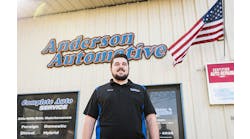SHOP STATS: NEALEY AUTO SERVICE Location: EDGEWATER, MD. Size: 3,000 square feet Staff Size: 5 (2 technicians, 1 helper, 1 owner/technician, 1 owner/service advisor) Number of Lifts: 970 Average Monthly Car Count: 120 Annual Revenue: $500,000
AJ Nealey understands the reaction—if you’re a customer delivering your vehicle to a one-bay auto repair shop outfitted in a backyard garage, your expectations aren’t very high.
At the very least, you’re not expecting a digital inspection report.
But then again, you haven’t been to Nealey Auto Service.
“Customers were blown away,” Nealey says. “They couldn’t believe the quality we were delivering as a two-man shop.”
It’s easy to get stuck in the old ways, Nealey says. With 15 years of experience in the automotive repair industry, he bounced from old-school shop to old-school shop as a technician for years. And when it came to opening his own business, Nealey Auto Service, he knew he didn’t want to just follow suit—he wanted to incorporate the next wave of technology from the word “go.”
“I think that’s one of the biggest things driving me,” he says. “It’s time for this industry to change, and we want to be at the forefront of that.”
Easier said than done, however. As a new owner six years ago with lofty goals of expanding his Edgewater, Md., shop—which he has now grown to a 3,000-square-foot facility with five employees—Nealey dove headfirst into implementing digital inspections, learning the ins and outs of choosing the right software, implementing it into the repair process, and, ultimately, achieving a return on investment.
The Backstory
The first few years of Nealey’s shop owner experience were off-and-on. Six years ago, when the shop opened in his garage, Nealey was balancing scheduling repairs and racing cars around the country. But as the years went on, he knew auto repair was where his passion sat.
So, two years ago, he decided to focus entirely on growing his business, which has developed into his current five-employee shop. This included a decision to implement digital inspections, which he says helped him and his wife, Stephanie, the shop’s estimator, reach $300,000 in annual revenue just last year.
The Problem
Implementing digital inspections wasn’t necessarily Nealey’s problem. In fact, he says setting up the technology (his shop uses Bolt On Technology for inspections) in his one-bay shop was quite simple to manage on his own. But regardless of the system used, there are processes to consider.
As Nealey's shop grew to a staff of four technicians (one part-time) in June 2016 at the 3,000-square-foot facility, the system suddenly required collaboration and established SOPs to ensure it made the repair process easier for each and every customer—and so, eventually, it would improve the shop’s sales and raise ARO by 70 percent.
The Solution
As Nealey has learned to utilize his digital inspection software to the fullest extent, it coincided with his ability to manage a larger staff. Here were his steps for making digital inspections part of the everyday:
Buy everyone tablets. As of now, Nealey Auto Service has five tablets—one for each employee. Nealey says you can easily find cheap, refurbished tablets on Amazon, but make sure they have a flash camera available. He says the Android tablets are reasonably priced (between $50 and $100) and are very durable.
Establish an inspection policy. To ensure the digital inspection software is used to its fullest extent, Nealey requires two different kinds of inspections from his technicians on each and every repair.
The first is a courtesy safety inspection, which is performed on every vehicle when it comes through the shop. On their tablets, technicians go through the 50-point inspection process, marking any necessary repairs or maintenance and making notes in the designated section. He pays his technicians 0.3 hours for the inspection, which is usually all it takes to complete one.
“If I'm a tech and I'm not getting paid to do a full courtesy inspection, I would see that as a burden on my day,” Nealey says.
The technicians use three different colors for each line item on the inspection sheet: Green means no repair is required; yellow means to watch for it next time; and red means it requires immediate attention.
The second inspection is a customer complaint inspection, where the techs evaluate a driver’s complaint and confirm whether a repair is necessary.
“With a new technician using it, you have to be with them for the first few weeks as they go through the inspection to make sure they're filling out everything correctly,” Nealey says.
Tweak the policy. One of Nealey’s biggest takeaways for improving inspections has been the importance of asking his team for feedback.
“Just today, my tech made a note about how our inspection report doesn’t have anything about mismatched tires,” he says. “So I just went in and added a technician note under "front tire" and "rear tire" and put "mismatched" as the heading, and then typed in a description and it's all right there. Now, as they are going through, they can click that checkbox if it's a mismatched scenario.”
Take photos. In either inspection scenario, technicians will take photos of every repair they find necessary. Those photos go right into the shop’s management system, where the service advisor can utilize them for sending electronic estimates to customers.
Double up on estimates and repairs. In fact, as the service advisor receives those photos, it presents the shop with the unique ability to start writing the estimate before the repair is even finished.
“In real time, we can see them click away as they’re completing the inspection,” Nealey says. “We can be right there with them every step of the way.”
Once the inspection is complete, the service advisor can head into the inspection and clean up any grammar mistakes and have the estimate put together rather quickly.
Send the estimate. The estimate is then sent to the customer using the customer’s preferred contact method—which is asked for when the vehicle is dropped off—and five minutes after clicking on the estimate (which the service advisor can see), the service advisor will call the customer.
“It’s been great for selling more repairs,” Nealey says. “People could be sitting in a meeting, just scrolling through that inspection, and they can text back, ‘What does it cost to just do it all?’”
The Aftermath
Although Nealey says he and his staff will never be done perfecting the digital inspection process, he says understanding the bare bones of the process is quite simple and only took his techs two weeks to make it a habit.
As a result, ARO has jumped from $380 to $550 in just the past six months, and sales hit $500,000 in 2016. With more staff members, a higher car count and a growing reputation in his neighborhood, Nealey says his business is poised for a breakout year in 2017 (at the current workload and pace, the shop will hit close to $800,000 in annual revenue).
The three colors used for inspections have allowed Nealey’s technicians to jump right into the vehicle’s history and know which items had previously been colored yellow, which has sped up their ability to pinpoint necessary repairs.
The Takeaway
Nealey says his attention to technology has helped him stand apart from the competition in his affluent neighborhood, which he says is positioning him to grow his customer base in 2017—thanks in large part to digital inspections.
“It’s the only way we communicate with customers,” he says. “Every customer gets a link on their invoice, and it makes the purchase easier for the customer. They don’t have to take a leap of faith. They see everything we’re seeing. I think that improves your trust with customers, and your retention skyrockets.”
EXPERT ADVICE
Holding Technicians Accountable for Inspections
Rich Margo, a past Ratchet+Wrench feature subject, turned around a flailing Honest-1 Auto Care in Las Vegas in 30 days, and he credits that in large part to improving inspections. While paying technicians for courtesy inspections helps, it doesn’t always guarantee they’ll consistently follow through with quality inspections. Here’s how he says you can ensure just that:
At a minimum, you need to be going through inspection reports weekly, if not daily. Randomly grab a stack of paperwork from a day of sales, and identify every tech and how they’re looking at cars when the shop is busy. You can tell when someone has a motorized pencil and churns out the same RO each time.
It’s all about continual follow-up. You need to have a conversation about your expectations for your technicians. If you run into someone not living up to your standards, you should start out with positive reinforcement. First remind them that the labor guide time includes inspections: “This is going to help you make money, and help us as a company make money.”
If there are continued deficiencies in that area, then it’s time to go harder on them. If you’ve got somebody who's not doing inspections, no matter how many times you talk to them, they’re not on your team.



